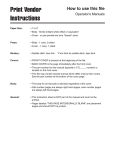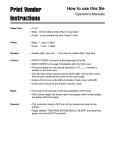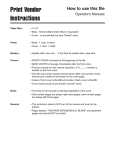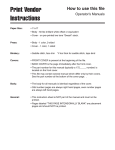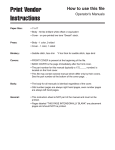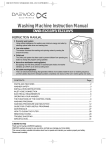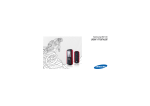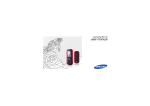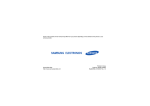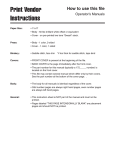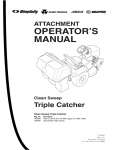Download Simplicity Clean Sweep Twin Catcher Operator`s manual
Transcript
Print Vendor Instructions Paper Size: How to use this file Operator’s Manuals • 11x17 • Body - 50 lbs brilliant white offset or equivalent • Cover - on pre-printed two tone “Swash” stock. Press: • Body - 1 color, 2-sided • Cover - 1 color, 1 sided Bindery: • Saddle stitch, face trim *if too thick for saddle stitch, tape bind Covers: • FRONT COVER is present at the beginning of the file. • BACK COVER is the page immediately after the front cover. • The part number for this manual (typically a 172_____ number) is located on the front cover. • This file may contain several manual which differ only by their covers. See the part number at the bottom of the cover page. . Body: • The body for all manuals is identical regardless of the cover. • Odd number pages are always right hand pages, even number pages are always left hand pages. General: • This instruction sheet is NOT part of the manual and must not be printed. • Pages labeled “THIS PAGE INTENSIONALLY BLANK” are placement pages and should NOT be printed. THIS PAGE INTENTIONALLY BLANK (FOR PLACEMENT ONLY - DO NOT PRINT) OPERATOR’S MANUAL Clean Sweep Twin Catcher Clean Sweep Twin Catchers Mfg. No. 1692149 1692150 Description Clean Sweep Twin Catcher (for 30” Mower Decks) Clean Sweep Twin Catcher (for 34” Mower Decks) 1709142-08 Rev 04/2004 TP 100-2181-08-AT-UV MANUFACTURING, INC. 500 N Spring Street / PO Box 997 Port Washington, WI 53074-0997 www.simplicitymfg.com © Copyright 2004 Simplicity Manufacturing, Inc. All Rights Reserved. Printed in USA. Table of Contents Safety Rules & Information General Warnings............................................2 Safety Decals ..................................................2 General Operating Instructions Mowing with the Catcher .................................3 Required Accessories......................................3 After Operation ................................................3 Operation & Storage Before Operation .............................................4 Operation.........................................................4 Emptying the Bags ..........................................4 Storage ............................................................4 Normal Installation & Removal Installation & Removal .....................................5 Troubleshooting Chart................................................................7 Initial Setup & Assembly 30” Models - Blade and Adapter Assembly .....8 34” Models - Baffle, Blade, & Adapter Assy...10 Frame & Bagger Support Assy. - All ..............12 Grass Catcher Assy. - All...............................13 Supplemental Kit Instructions Baffle Kit Instructions.....................................16 Heat Shield Kit Instructions ...........................17 Hardware Identification & Torque Chart..............................................................18 1 Safety Rules & Information Read these safety rules and follow them closely. Failure to obey these rules could result in loss of control of unit, severe personal injury or death to you, or bystanders, or damage to property or equipment. The triangle in text signifies important cautions or warnings which must be followed. GENERAL WARNINGS • Know the unit’s controls and how to stop quickly. READ THE OPERATOR’S MANUALS. • Read and obey all safety decals. • Only allow responsible adults, who are familiar with the instructions, to operate the unit. • Disengage the PTO. Shut off the engine and wait for all moving parts to stop before attaching, adjusting, or disconnecting any part of the collection system. • Check the collection system to make sure it is bolted tightly to the unit. • DO NOT operate the unit without either the entire grass catcher or the deflector in place. • Turn off the PTO to disengage the blades when not mowing. • DO NOT mow in reverse. Always look down and behind before and while travelling in reverse. • DO NOT turn sharply when travelling alongside a building or any object. Slow down before turning. • DO NOT carry passengers. • When collection system is removed from the mower deck, the deflector must be properly installed. • Collector bags are subject to deterioration and wear during normal use. Inspect the bag periodically for tears, holes, or weak spots and replace with a new bag that meets manufacturer’s durability standards. • If the mower stalls or the collector chute plugs: 1. Disengage the PTO; 2. Stop the engine and remove the key; 3. Set the parking brake, and wait for all moving parts to stop. 4. Remove the foreign object or clear the chute with a piece of wood before restarting the engine. NEVER place hands into COLLECTOR OR MOWER housing to clear jammed objectS. Blower OR MOWER may rotate when object is removed. • For added stability and to prevent tipping or loss of control: a. Use reduced speed on uneven ground and when turning corners. b. Reduce loads on hillsides. It is recommended that the collection system be kept only half full when negotiating any slopes. Start mowing on slopes when the collection system is empty. c. Mow up and down the face of slopes; never across the face of any slope. • When operating on slopes, use front counterweights. Never operate on slopes greater than 17.6% (10°). SAFETY DECALS These labels are easily applied and will act as a constant visual reminder to you, and others who may use the equipment, to follow the safety instructions necessary for safe, effective operation. This unit has been designed and manufactured to provide you with the safety and reliability you would expect from an industry leader in outdoor power equipment manufacturing. ATTACHMENT DECALS Although reading this manual and the safety instructions it contains will provide you with the necessary basic knowledge to operate this equipment safely and effectively, we have placed several safety labels on the unit to remind you of this important information while you are operating your unit. WARNING • Do not open cover with engine running. • Do not operate mower without the complete catcher in place • When operating on slopes, refer to operator's manual for counterweights. All DANGER, WARNING, CAUTION and instructional messages on your rider, attachments and mower should be carefully read and obeyed. Personal bodily injury can result when these instructions are not followed. The information is for your safety and it is important! The safety decals below are on your product. 1704405 DANGER DANGER ROTATING BLADES ROTATING CUTTING BLADE DO NOT OPERATE MOWER WITHOUT DEFLECTOR OR ENTIRE GRASS CATCHER IN PLACE If any decals are lost or damaged, replace them at once. See your local dealer for replacements. SHUT OFF MOWER AND TRACTOR BEFORE SERVICING OR CLEANING BLOWER AND MOWER. 1700259 Read and obey all operation and warning decals. TP 600-2562-01-AT-SMA 2 General Operating Instructions BEFORE OPERATION Clear the lawn of all sticks, stones, wire and other debris which may be caught or thrown by the mower blades. Check grass condition. If wet, wait until later in the day. If grass is wet, the grass catcher is likely to become plugged. For efficient bagging, air circulation under the mower deck, through the chute and into the bag is very important. For this reason, BEFORE YOU BEGIN MOWING you should make certain the underside of the mower and the underside of the catcher lid are free from grass and debris. Make sure that there is a snug fit between mower deck, blower housing, tubes, and grass catcher cover. MOWING WITH THE CATCHER REQUIRED ACCESSORIES Always operate with throttle at full speed when mowing. A front-mounted weight carrier and approved weights are required when using this rear-mounted grass catcher. Never operate on slopes greater than 17.6% (10°). Grass should be cut often, and not too short. If grass is too long or lush it may be necessary to keep ground speed to a minimum or to cut only half the width of the mower to prevent clogging. If grass is long, operate with mower in high cutting position for first pass, cutting again in a lower position on a second pass. AFTER OPERATION Remove any debris from the the screen on the underside of the lid. Note: The lid screen can be partially removed for easier cleaning and should be cleaned regularly. Do not open the cover with mower engaged. The blower housing and tube should be removed for cleaning. If a large amount of cut grass is spilling out from under deck, the tube may be plugged or the bags may be full— discontinue mowing, stop the rider, disengage the PTO, shut off the engine and then empty the catcher or clear the tube. Inspect the grass bags for wear or damage. Make sure that there is a snug fit between mower deck, blower housing, tubes, and grass catcher cover. STORING THE GRASS CATCHER WARNING Clean the grass catcher thoroughly using a mild detergent (other products may damage the tube). Remove any debris from the the screen on the underside of the lid. ALWAYS shut off the tractor. Disengage the PTO, and allow all moving parts to stop BEFORE disconnecting or clearing tube, or emptying catcher. If paint has been scratched on metal parts, touch up with paint, or apply a thin film of oil to prevent corrosion. Before leaving the operator’s position for any reason, engage the parking brake, disengage the PTO, stop the engine and remove the key. Store in a dry area. Dry thoroughly before storing for a long period of time. Always store away from moisture. To reduce fire hazard, keep the engine, rider and mower free of grass, leaves and excess grease. Do not stop or park rider over dry leaves, grass or combustible materials. 3 Operation & Storage OPERATION WARNING Grass should be cut often, and not too short. If grass is too long or lush, it may be necessary to keep ground speed to a minimum or to cut only half the width to prevent clogging. If grass is high, operate with mower in high cutting position. Cut the grass again in lower cutting position, if desired. For safety reasons grass and debris are to be removed from tube and adapter only after engine is shut off, key removed and all moving parts stopped. WARNING To check if grass is flowing up tube, view tube through rear inspection window. Do not open cover with mower engaged. Before raising bagger cover, shut off engine, remove key and set parking brake. To check if grass bags are full, reach back and feel top of right bag (left bag will fill first) or view tube through front inspection window. BEFORE OPERATION Clear the lawn of all sticks, stones, wire and other debris, which may be caught or thrown by the mower blades. If a large amount of cut grass is spilling out from under deck, the tube may be plugged or grass bags are full. Shut off rider, disengage PTO and allow all moving parts to stop before disconnecting tube. Clean the tube with mild detergent (other products may damage tube). Inspection windows can be removed to be cleaned. Make sure windows are securely in place before operating. NOTE: If mower deck is equipped with Mulching Kit, the mulching baffles must be removed for grass collection. Make sure the high-lift blades (packaged with the Grass Bagger Kit) are installed (See Assembly Instructions at the back of this manual). Standard low-lift blades are recommended for mulching operation. Check grass condition. If wet, wait until later in the day. If grass is wet, plugging may occur. For efficient bagging, air circulation under the mower deck, through the chute and into the bag is very important. For this reason, you should remove grass and debris from underside of mower deck, discharge chute and screen inside cover. Always operate with throttle at full speed. EMPTYING THE BAGS The adapter and tube should be removed for cleaning. Unhook the wire form and remove the tube from the adapter. Loosen the wing nut securing the adapter to mower deck. Raise the bagger cover. If a plastic liner was not used, unhook the bag and turn upside down to empty (use handle on bottom). If plastic liner was used, first tie top of liner closed. Then, either pull the liner out, or turn the bag upside down and allow the filled liner to slide out. If desired, the bags can be lined with 30-gallon trash bags for easy disposal. Inspect the grass bags for wear or damage. Make sure that there is a snug fit between mower deck, adapter, tubes and grass bag cover. STORAGE Clean the grass catcher thoroughly. If paint has been scratched on metal parts, coat with paint or oil. Store in a dry area. Hang the bags to dry. Always store away from moisture. 4 Normal Installation & Removal INSTALLATION & REMOVAL NOTE: For first-time installation, refer to Initial Setup & Installation. NOTE: If mower deck is equipped with Mulching Kit, the mulching baffles must be removed for grass collection. Make sure the high-lift blades (34') or high-lift tabs (30') are installed per the Assembly Instructions at the back of this manual. 1. Install the grass bag and bracket assembly (A, figure 1) on the anchor assemblies (B) located on each side of the transmission housing. Push forward so the bracket assembly rests fully on the anchors. 2. Insert the round pin (C) through the bracket assembly and frame, and secure it using the safety clip pin (D). NOTE: If grass bag and bracket assembly is too bulky to install as one piece, separate the grass bag cover (A, figure 2) from the upright support (B) by removing clips (D) and long clevis pins (C). Reinstall cover after support assembly is properly installed. 5 Normal Installation & Removal Figure 3. A. Grass Bag Frame B. Support Bracket Figure 4. (30” Mower Shown) A. Adapter B. Wing Nut C. Deflector D. Jam nut, 5/16-18 E. 1/2” Hole 3. Open grass bag cover and install grass bag frames (A, figure 3) to support brackets (B). 4. On 30" mower, lift the deflector (C) up and install the adapter (A, figure 4) to mower deck by hooking bracket over the rear carriage bolt and securing with jam nut (D) and positioning front slot on the adapter under wing nut (B). Secure by tightening knob and wing nut. Make sure that bottom of adapter is below stone guard. On 34" mower, lift up deflector (C) and install the adapter by hooking rear bracket over the mower hinge rod and positioning front slot on the adapter under wing nut (B). Tighten wing nut. Make sure that bottom of adapter is below stone guard. 5. Apply dry talc to rubber seal at cover opening. Install tube (A, figure 5) as far as possible into opening to clear adapter and install over adapter. Secure by rotating wire form (B) down into locked position over puck on adapter. 6. To remove the grass catcher assembly, reverse steps 1 - 5. Make sure deflector (C, Figure 4) is in proper operating position after removal of grass catcher adapter. 6 Troubleshooting The following table provides troubleshooting instructions for the more common and easily corrected problems. For problems not covered in the table, see your dealer. WARNING To avoid serious Injury, perform maintenance on the grass catcher only after stopping the engine and waiting for all moving parts to come to a complete stop. Always remove the ignition key before beginning the maintenance to prevent accidental starting of the engine. Disconnect the spark plug wire and fasten away from plug. Problem Cause/Solution 1. Leaves and grass not being completely picked up. A. Engine speed too slow. Run at full throttle. B. Ground speed too fast. Use lower speed. C. Discharge tube plugged. Stop engine and remove key. Then remove and unplug discharge tube. D. Using wrong mower blades. See Assy. Instructions. E. Blades not tight. Torque to 60 ft. lbs. F. Mower not level. See rider Operators Manual to level. G. Belt or clutch slipping. See rider Operator's Manual for adjustment. 2. Grass catcher discharge tube or mower plugs easily. A. Bags full. Empty bags. B. Grass too high. Reduce rider ground speed, reduce cutting width or raise mower adjustment for the first pass, lower it for the second pass. C. Grass or leaves too wet. Wait for drier conditions. D. Build-up of cut grass in mower or adapter. Clean thoroughly. E. Screen in grass bag cover clogged. Remove cover and clean screens. F. Using wrong mower blades. See Assy. instructions. G. Belt or clutch slipping. See rider Operator's Manual for adjustment. H. Cutting off too much grass. High-lift blades and adapter collect best when 1-1/2" above ground. I. Engine not running at full throttle. Use transmission lever to control ground speed and keep engine at full throttle. Table 1. Troubleshooting 7 Initial Setup & Assembly 30” MODELS BLADE AND ADAPTER ASSEMBLY Blade Assembly - 30” Mower 1. Remove the mower deck to access the blade or using an overhead hoist, elevate the front of the unit to access the mower blade. 2. Mount the lifts (B, Figure 6) to the discharge side of the blade as shown. Torque nuts to 14 ft. lbs. Adapter & Mounting Hardware Installation 30” Mower D C 1. Install reinforcement strap (A, figure 7) inside the adapter and secure it to the top outer holes using two 10-24 x 5/8" flat head screws (B), flat washers (C) and 10-24 nuts (D). Be sure the cut-off bracket (G) is installed between the reinforcement plate (A) and adapter. D A C 2. In rear hole of mower deck, install 5/16-18 x 1-1/4 carriage bolt (E) from the bottom and secure with 5/16" jam nut (F). A F B E Figure 7. A. Reinforcement Plate B. Flathead Screw, 10-1/4 x 5*8 C. Flat Washer D. Nut E. Carriage Bolt, 5/16-18 x 1-1/4 F. Jam But, 5/16-18 G. Cut-Off Bracket 8 Initial Setup - 30” Models E A C D E 1/4" B Drill 1/2" Hole 1" Figure 8. A. Carriage Bolt, 5/16-18 x 2-1/4 B. Cup C. Whiz Flange Nut, 5/16 D. Wing Nut E. Centerlock Nut, 5/16 E Figure 9. (30” Mower Shown) A. Adapter B. Wing Nut C. Deflector D. Jam nut, 5/16-18 E. 1/2” Hole 3. Install 5/16-18 x 2-1/4 carriage bolt (A, figure 8) through front hole in mower deck along with cup (B), whiz flange nut (C), wing nut (D) and center lock nut (E). Nut (C) must be seated inside cup and center lock nut (E) should be flush with end of carriage bolt. 4. Place adapter over rear carriage bolt (A, figure 9) and position front slot of adapter between mower deck and wing nut (B). Install jam nut (C) on carriage bolt. Securely tighten both jam nut and wing nut. 5. Go to FRAME AND BAGGER SUPPORT ASSEMBLY - ALL MODELS to continue assembly procedures. 9 Initial Setup - 34” Models 34" MODELS BAFFLE, BLADE, & ADAPTER ASSEMBLY E I D H K G B H Install Baffle F C 1. Remove mower deck from rider. Position mower deck upright and support in this position. J A 2. Position baffle with notched end towards discharge side opening, Install all hardware as shown in figure 10. The notch must be positioned to clear the stone guard weldment. M L 3. Tighten all hardware at the discharge side of baffle first, then tighten hardware at the middle of baffle, and finally tighten hardware at inside location. Figure 10. Install Baffle - 34” Models A. Carriage Bolt, 5/16-18 x 2-1/4 B. Cup C. Flange Nut, 5/16 D. Wingnut Assy. E. Centerlock Nut, 5/16 F. Carriage Bolt, 5/16-18 x 1-3/4 G. Spacer (Between Baffle & Deck) H. Lockwasher, 5/16 I. Nut, 5/16 J. Carriage Bolt, 5/16-18 x 3/4 K. Nut, 5/16 L. Blade Tabs M. High-Lift Blade Install Blades Later Models with Hex Arbor 1. Remove existing discharge-side blade but retain hardware. 2. Install the new high-lift blade (D, figure 11a) with the tabs pointing up toward the bottom of the deck. Secure with original hardware and torque capscrew (H) to 45-55 ft. lbs. (61-75 N.m.). NOTE: Discard the 2" O.D. splined adapter provided with the bagger; it is not used with later model decks. Figure 11a. Install High-Lift Blade - Later Models A. Washer E. Blade, 16-1/8” B. Arbor Shaft F. Hex Washer C. Grass Shield G. Spring Washer D. High-Lift Blade H. Capscrew 10 Initial Setup - 34” Models Install Blades Early Models with Splined Arbor 1. Remove existing discharge-side blade but retain hardware. Remove the retaining band (E, figure 11 b) from the arbor shaft and remove the existing splined adapter (3-3/8" O.D. F, figure 11b). This adapter can be discarded. The new 2" O.D. splined adapter supplied with the bagger can be used with regular or high-lift blades. Install the new 2" splined adapter with existing retaining band (E). 2. Install the new high-lift blade (D, figure 11 b) with the tabs pointing up toward the bottom of the deck. Secure with existing hardware (A, B, & C, figure 11b) and torque capscrew to 50-70 ft. lbs. (66-76 N.m.). NOTE: After complete assembly of collection system, test run mower to make sure blades do not contact baffle. Figure 11b. Install High-Lift Blade - Early Models A. Capscrew, 7/16-14 x 1 E. Retaining Band B. Spring Washer F. Splined Arbor C. Spline Washer G. Grass Shield D. Blade Adapter Installation 1. Place adapter over rear carriage bolt (A, figure 12) and position front slot of adapter between mower deck and wing nut (B). Install jam nut (C) on carriage bolt. Securely tighten both jam nut and wing nut. 2. Go to FRAME AND BAGGER SUPPORT ASSEMBLY - ALL MODELS to continue assembly procedures. Figure 12. A. Carriage Bolt B. Wing Nut C. Jam Nut, 5/16-18 11 Initial Setup - All Models FRAME & BAGGER SUPPORT ASSEMBLY - ALL MODELS H Note: Units with 0510 transmissions use anchors (A, figure 13) with a notch, all other units use anchor with no notch. See Inset Figure 13. D F 1. Assemble the two anchors (A, figure 13) to the transmission housing using the 5/16-18 x 3 capscrews (B), washers (C) and nuts (E). Install the capscrews from the bottom of transmission. Do not tighten hardware at this time. E A 2. Position support assembly (F, figure 13) on anchors and secure to rider with safety clip pin (G) and round pin (D). G 3. Fully seat each anchor into the support assembly tubes and square up bagger frame with rider frame. Tighten anchor mounting hardware securely. C 4. Place catcher support (H) into support assembly as shown (figure 13). B 0510 Transmssion Models (Notch) Figure 13. A. Anchor B. Capscrew, 5/16-18 x 3 C. Flat Washer, 5/16 D. Round Pin E. Nut, Flange Lock, 5/16 F. Support Assembly G. Safety Clip Pin H. Catcher Support 12 All Other Models (No Notch) Initial Setup - All Models GRASS CATCHER ASSEMBLY ALL MODELS NOTE: Cover and bag support are packaged as an assembly with long clevis pins and clips. It may be easier to separate components for the following step. 1. Install horizontal bag support (A, figure 14) to upright catcher support (B) holes as shown. Note that the open set of holes (D) is toward the discharge side of mower. Install four 3/8-16 x 7/8 capscrews (C) from the front and lightly secure with flange lock nuts. 2. Make sure bag support and catcher support are square, then tighten flange lock nuts. Figure 14. A. Bag Support B. Catcher Support C. Capscrew, 5/16-18 x 7/8 D. Open Set Of Holes 3. Reinstall grass catcher cover (A, figure 15) to support (B) and secure with clevis pins (C) and clips (D). Figure 15. A. Cover B. Support 4. Install handle (A, figure 16) to rear surface of lid with offset toward the rear. Secure with two 10-32 x 1/2 truss screws (B) and 10-32 hex nuts (C). Figure 16. A. Handle B. Truss Screw C. Hex Nut, 10-32 13 C. Clevis Pin D. Clip Initial Setup - All Models 5. Open cover and fasten cable (A, figure 17) to tube support (B) to prevent cover from going over center when opened. Loop end of cable fits over washer (C). Figure 17. A. Cable B. Support C. Washer 6. Open grass bag cover and install grass bag frames (A, figure 18) to support brackets (B). Make sure cover handle latches to grass bag frames. Figure 18. A. Grass Bag Frame B. Support Frame 14 Initial Setup - All Models 7. Apply dry talc powder to rubber seal at cover opening. Install tube (A, figure 19) as far as possible into opening to clear adapter and install over adapter. Figure 19. A. Tube B. Wire Form Location 8. Secure tube by moving wire form (A, figure 20) down over round cup (B) on adapter surface. Figure 20. A. Wire Form B. Round Cup 15 Installation Instructions Baffle Kit Part No. 1686783 For Coronet / 400 / 2400 Series Riders D A C B Figure 1. Installation This kit adds a baffle to twin bag grass catchers installed on Coronet / 400 / 2400 series riders. Kit Contents: Part No. 1720375 Qty. 1 Description Baffle INSTALLATION WARNING Before beginning any service work turn off the PTO, set the parking brake, turn off the ignition, and disconnect the spark plug wire(s). 1. Remove the hardware (D) securing the plastic elbow (C) to the metal support plate (B). 2. Insert the baffle (A) in between the support plate (B) and elbow (C). 3. Reinstall the hardware (D). MANUFACTURING, INC. 500 N Spring Street / PO Box 997 Port Washington, WI 53074-0997 USA Form No. 1720502-00 Rev. 3/99 © 1999 Simplicity Manufacturing, Inc. All Rights Reserved TP 200-2252-00-SK-SMA EXHAUST SHIELD KIT MFG. NO. 1666610 INSTALLATION INSTRUCTIONS 1. Raise the seat deck to expose the right-hand top duct. 2. See figure 1. Cut out the template below and place it on the duct with the edges aligned. Tape the template in place and drill out the holes as indicated using a 13/W drill bit. Figure 1. Placing Template for drilling holes 3. See figure 2. Install the front exhaust shield and rear exhaust shield using the hardware supplied with the kit. Tighten securely. Figure 2. Installing Exhaust Shields A. Front Exhaust Shield, (triangular) (sty. 1) B. Rear Exhaust Shield, (square) C. Screw, Truss Hd., MO-32 x l/2 D. Nut, Hex, w/washer, #lo-32 Exhaust Shield Mountlng Template FORM 1713321 PRINTED IN U.S.A. 12/93-300-VP Hardware Identification & Torque Specifications Common Hardware Types Torque Specification Chart Hex Head Capscrew FOR STANDARD MACHINE HARDWARE (Tolerance ± 20%) Washer Hardware Grade Lockwasher Carriage Bolt No Marks SAE Grade 2 Hex Nut Size Of Hardware Standard Hardware Sizing 8-32 8-36 10-24 10-32 1/4-20 1/4-28 5/16-18 5/16-24 3/8-16 3/8-24 7/16-14 7/16-20 1/2-13 1/2-20 9/16-12 9/16-18 5/8-11 5/8-18 3/4-10 3/4-16 7/8-9 7/8-14 1-8 1-12 When a washer or nut is identified as 1/2”, this is the Nominal size, meaning the inside diameter is 1/2 inch; if a second number is present it represent the threads per inch When bolt or capscrew is identified as 1/2 - 16 x 2”, this means the Nominal size, or body diameter is 1/2 inch; the second number represents the threads per inch (16 in this example, and the final number is the body length of the bolt or screw (in this example 2 inches long). The guides and ruler furnished below are designed to help you select the appropriate hardware and tools. 0 1/4 Nut, 1/2” 1/2 Inside Diameter 3/4 1 1/4 1/2 3/4 Screw, 1/2 x 2 2 1/4 Body Diameter in/lbs ft/lbs 19 20 27 31 66 76 11 12 20 23 30 35 50 55 65 75 90 100 160 180 140 155 220 240 Nm. 2.1 2.3 3.1 3.5 7.6 8.6 15.0 16.3 27.2 31.3 40.8 47.6 68.0 74.8 88.4 102.0 122.4 136 217.6 244.8 190.4 210.8 299.2 326.4 SAE Grade 5 in/lbs ft/lbs 30 31 43 49 8 10 17 19 30 35 50 55 75 90 110 120 150 180 260 300 400 440 580 640 SAE Grade 8 Nm. in/lbs ft/lbs Nm. 3.4 3.5 4.9 5.5 10.9 13.6 23.1 25.8 40.8 47.6 68.0 74.8 102.0 122.4 149.6 163.2 204.0 244.8 353.6 408.0 544.0 598.4 788.8 870.4 41 43 60 68 12 14 25 27 45 50 70 80 110 120 150 170 220 240 386 420 600 660 900 1,000 4.6 4.9 6.8 7.7 16.3 19.0 34.0 34.0 61.2 68.0 95.2 108.8 149.6 163.2 204.0 231.2 299.2 326.4 525.0 571.2 816.0 897.6 1,244.0 1,360.0 NOTES 1. These torque values are to be used for all hardware excluding: locknuts, self-tapping screws, thread forming screws, sheet metal screws and socket head setscrews. 2. Recommended seating torque values for locknuts: a. for prevailing torque locknuts - use 65% of grade 5 torques. b. for flange whizlock nuts and screws - use 135% of grade 5 torques. 3. Unless otherwise noted on assembly drawings, all torque values must meet this specification. 1/2 Body Length 3/4 3 1/4 1/2 3/4 4 Wrench & Fastener Size Guide 1/4 5/16 3/8 1/4” Bolt or Nut Wrench—7/16” 5/16” Bolt or Nut Wrench—1/2” 3/8” Bolt or Nut Wrench—9/16” 18 7/16 DIA. 7/16” Bolt or Nut Wrench (Bolt)—5/8” Wrench (Nut)—11/16” 1/2 DIA. 1/2” Bolt or Nut Wrench—3/4”






















